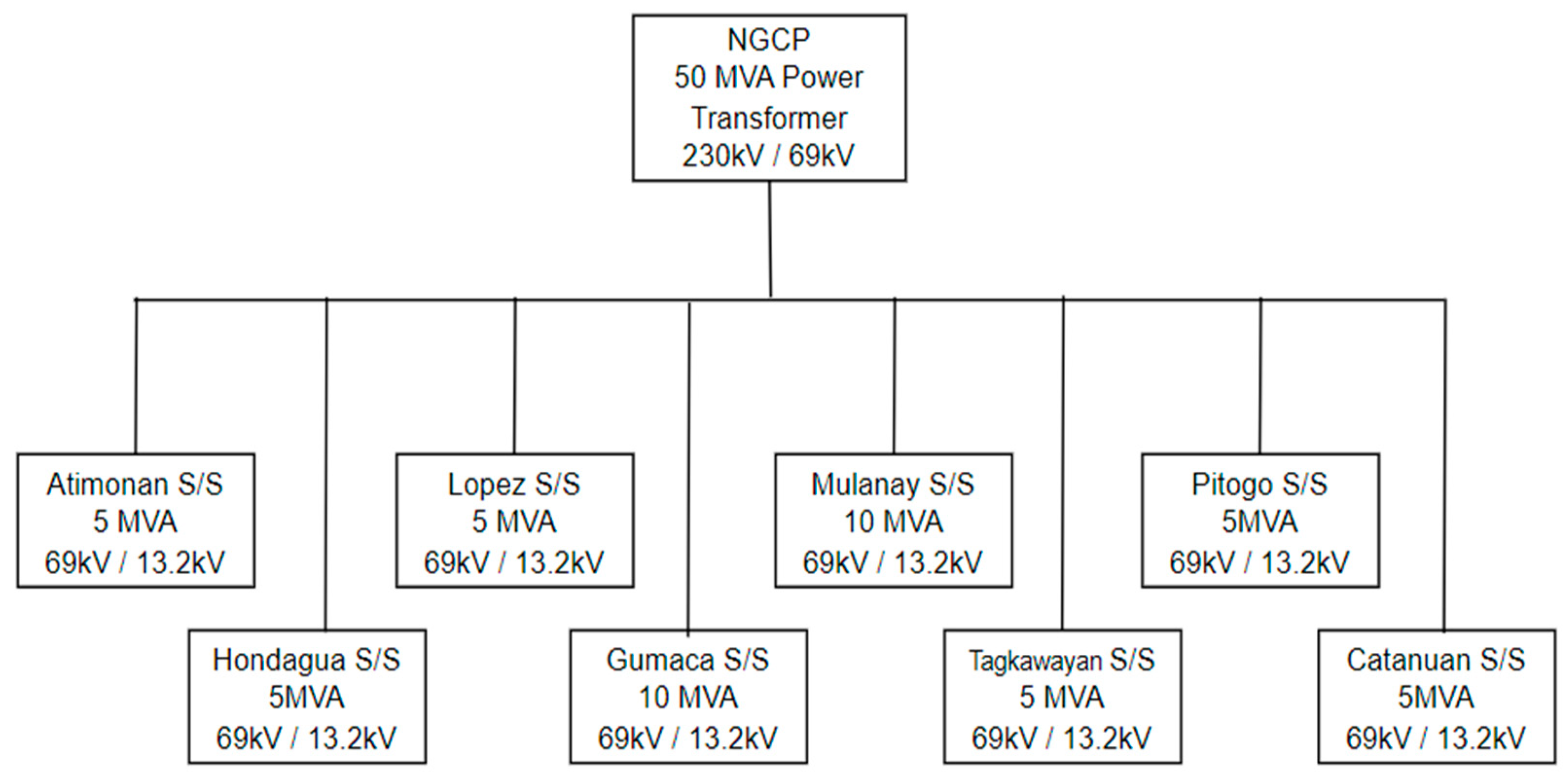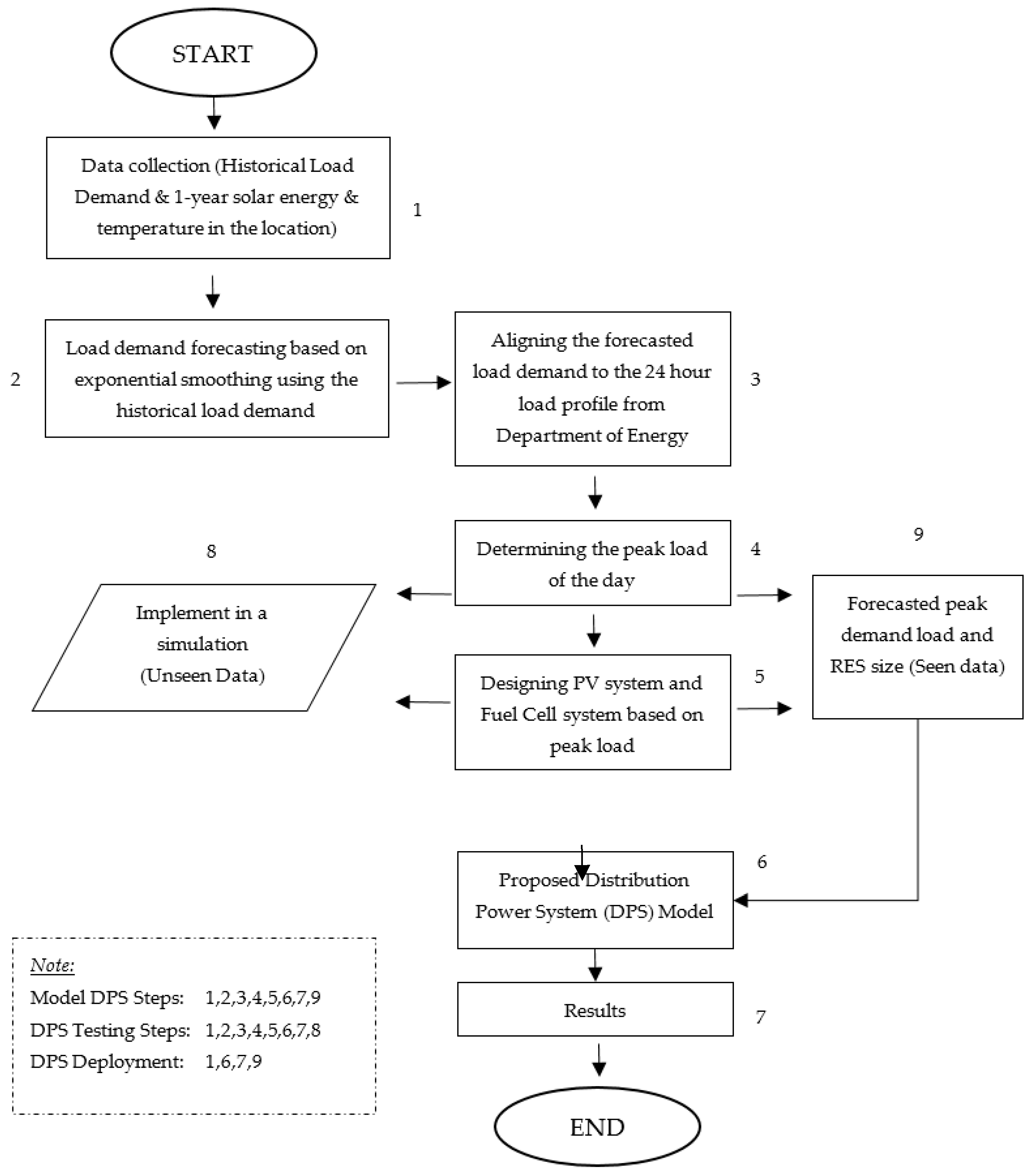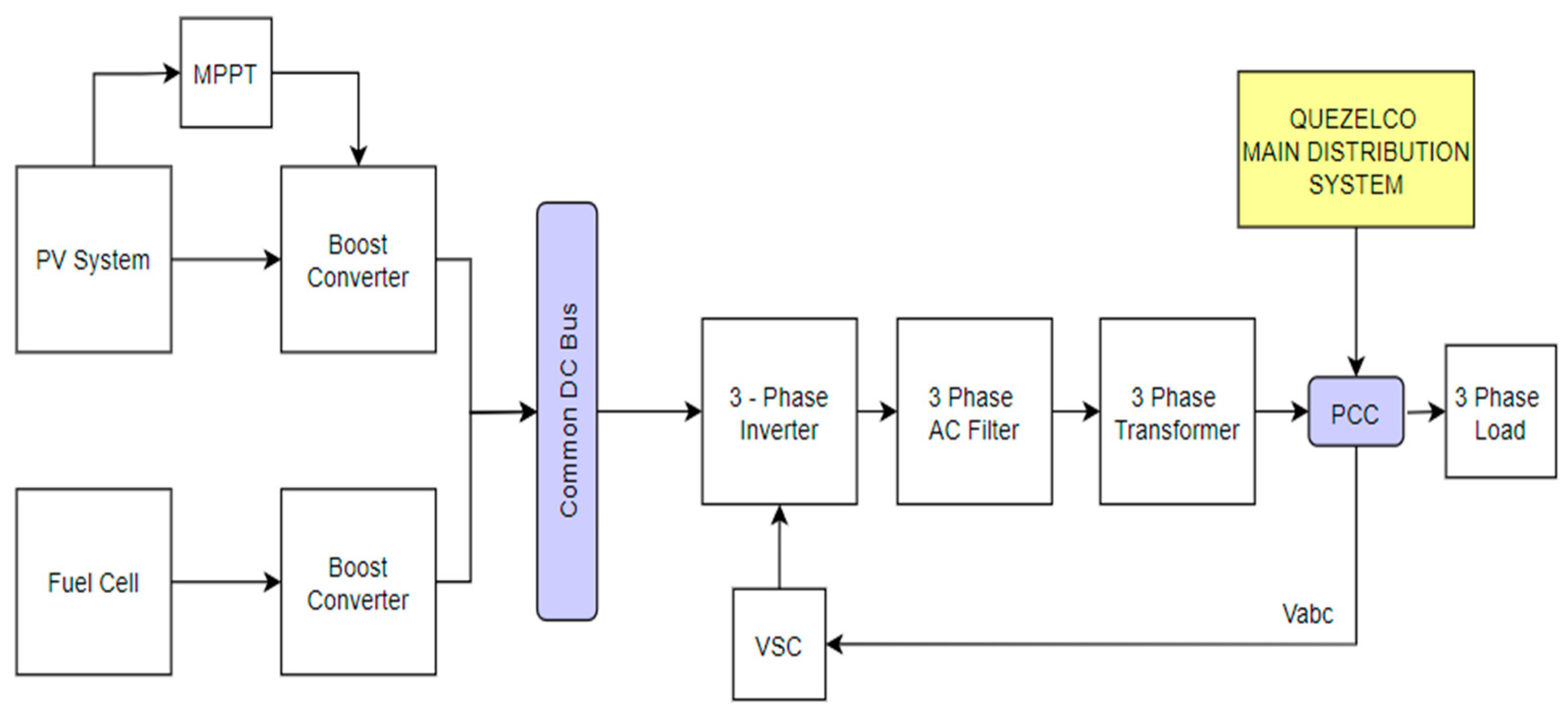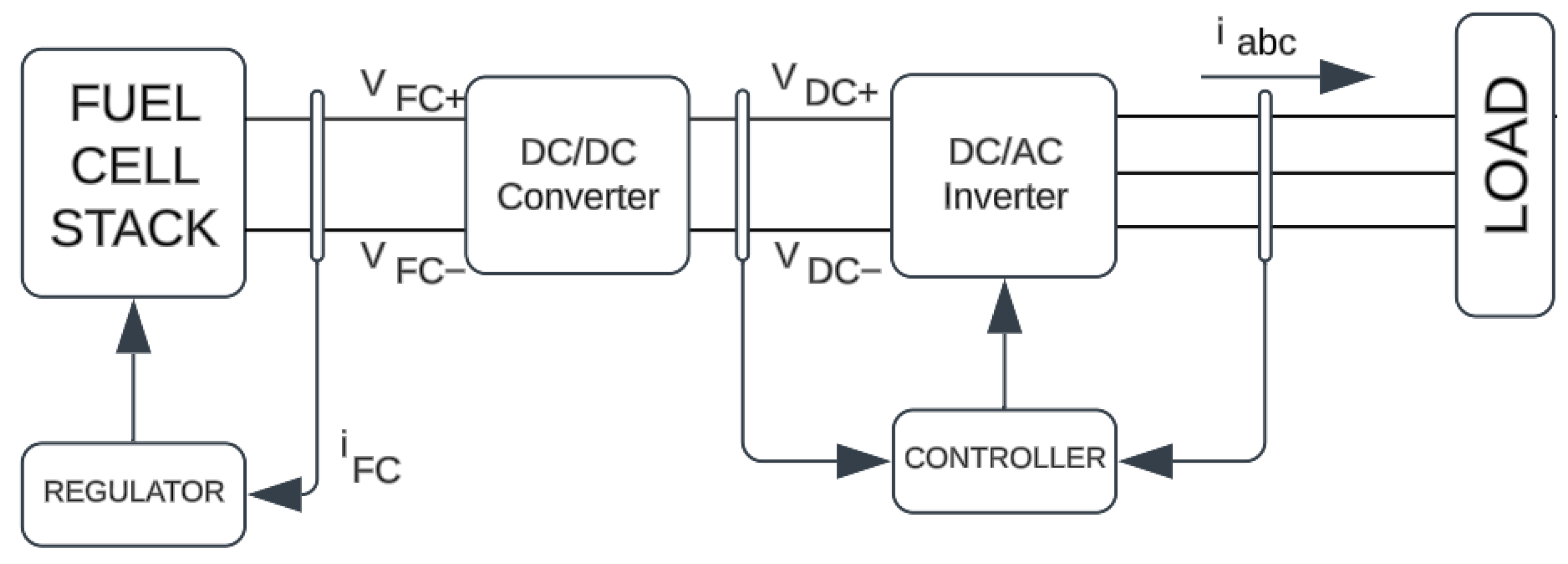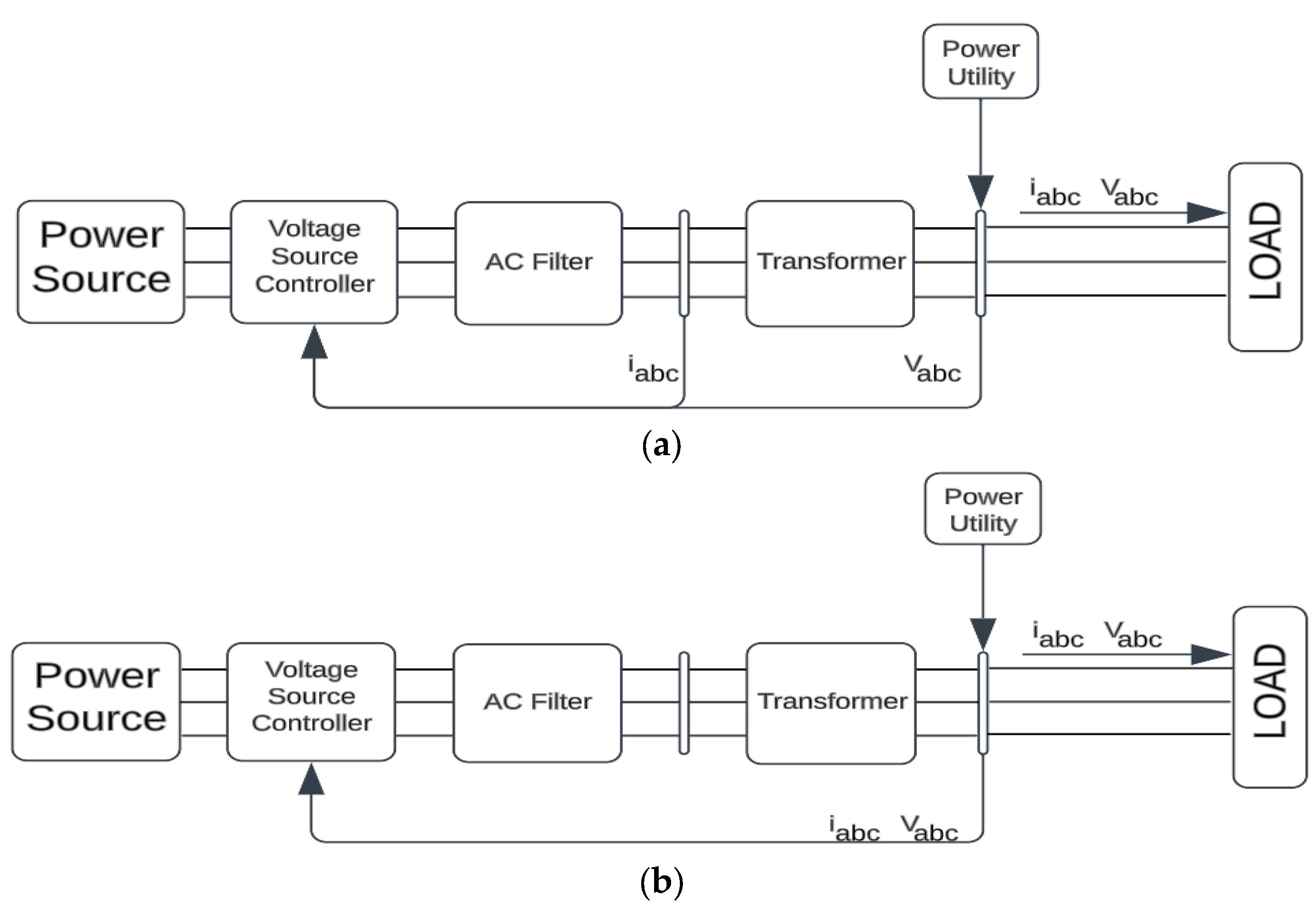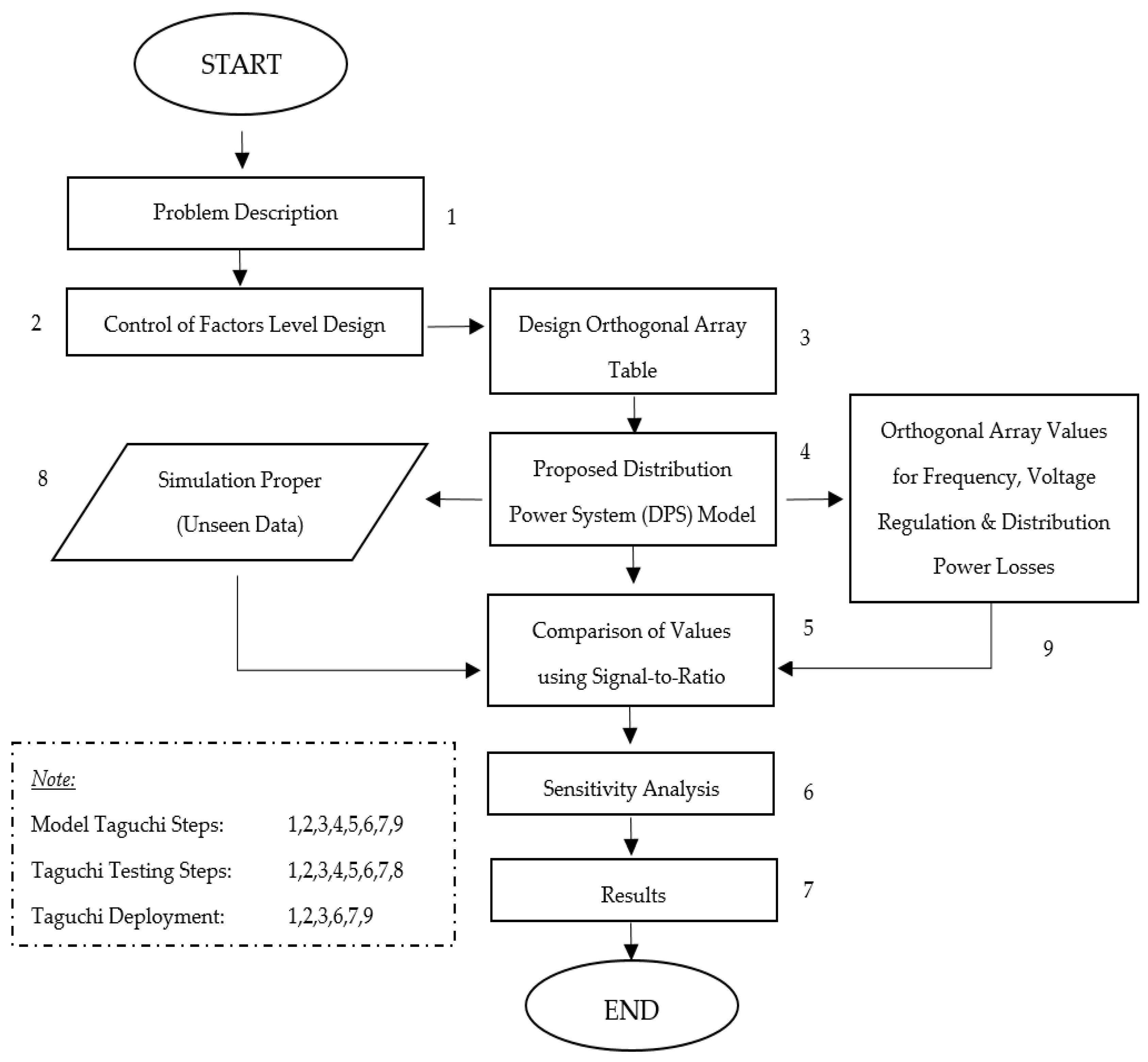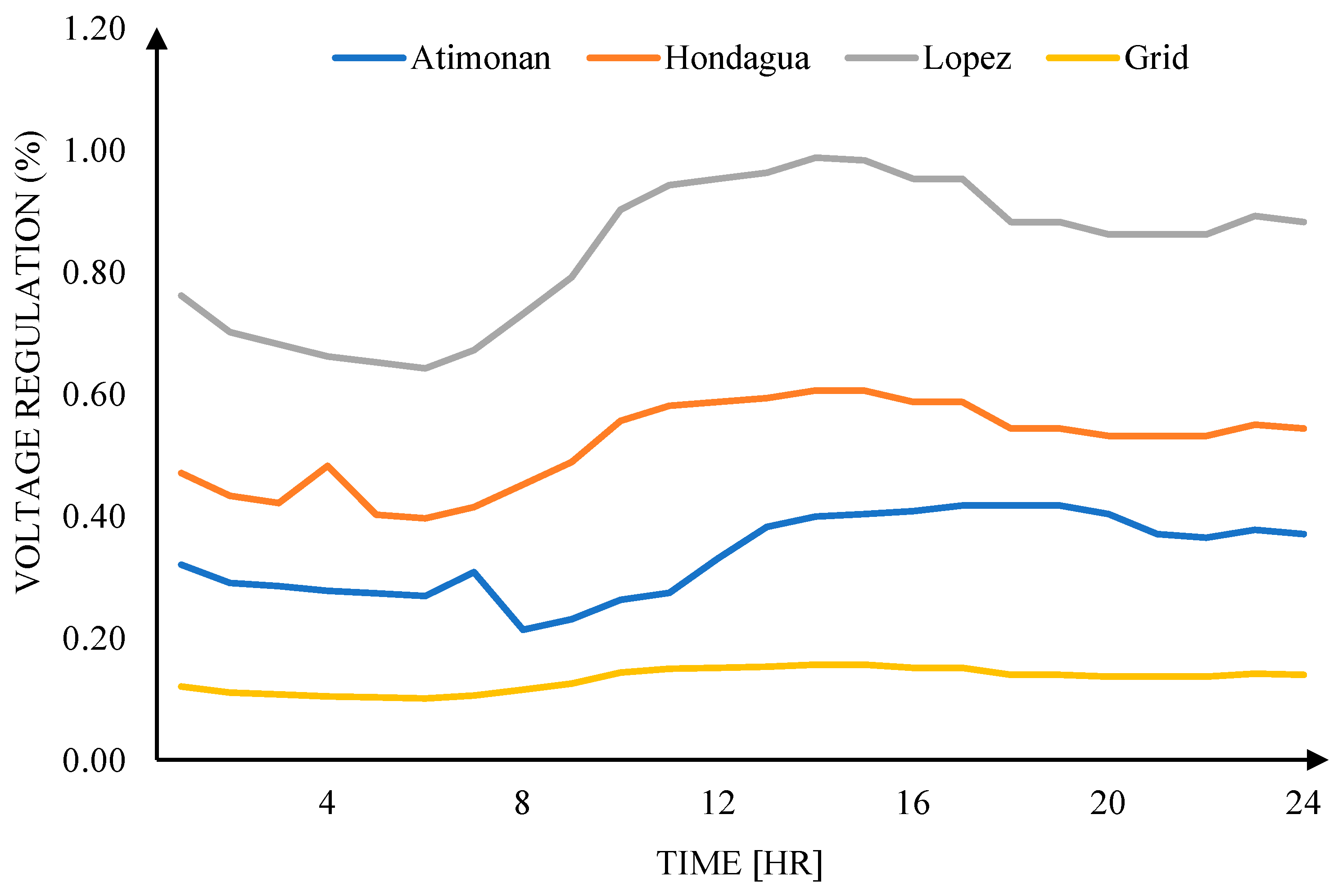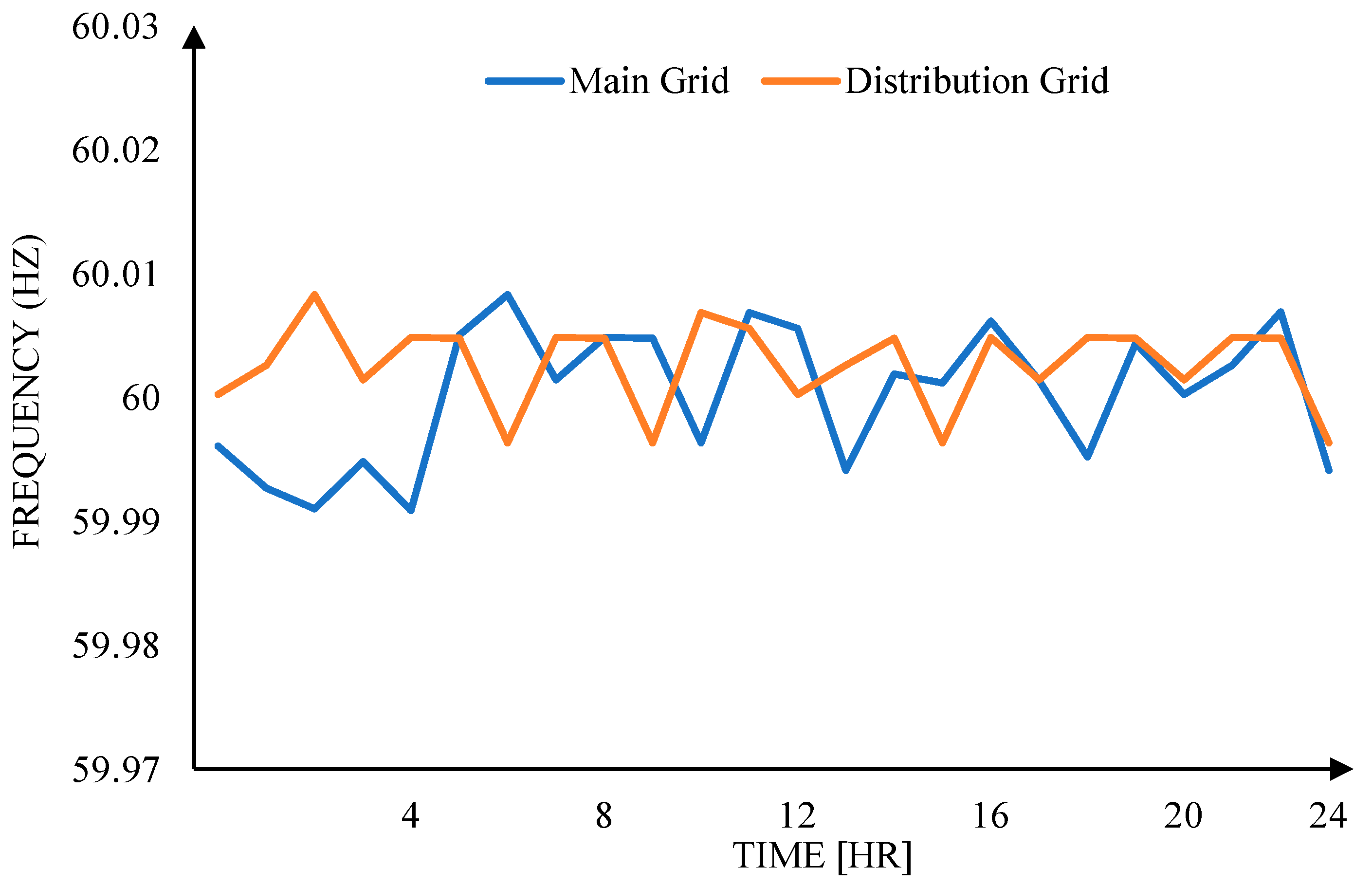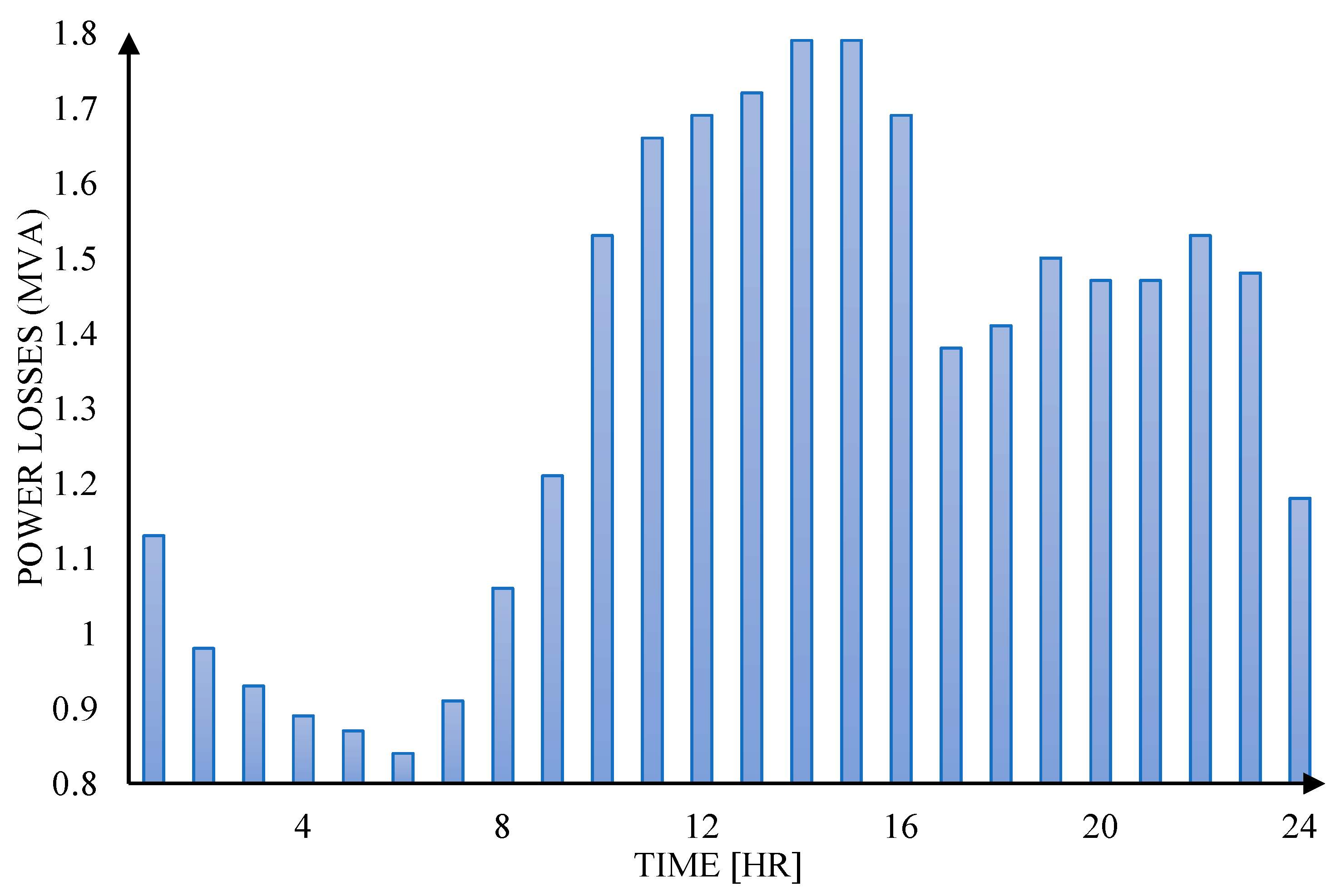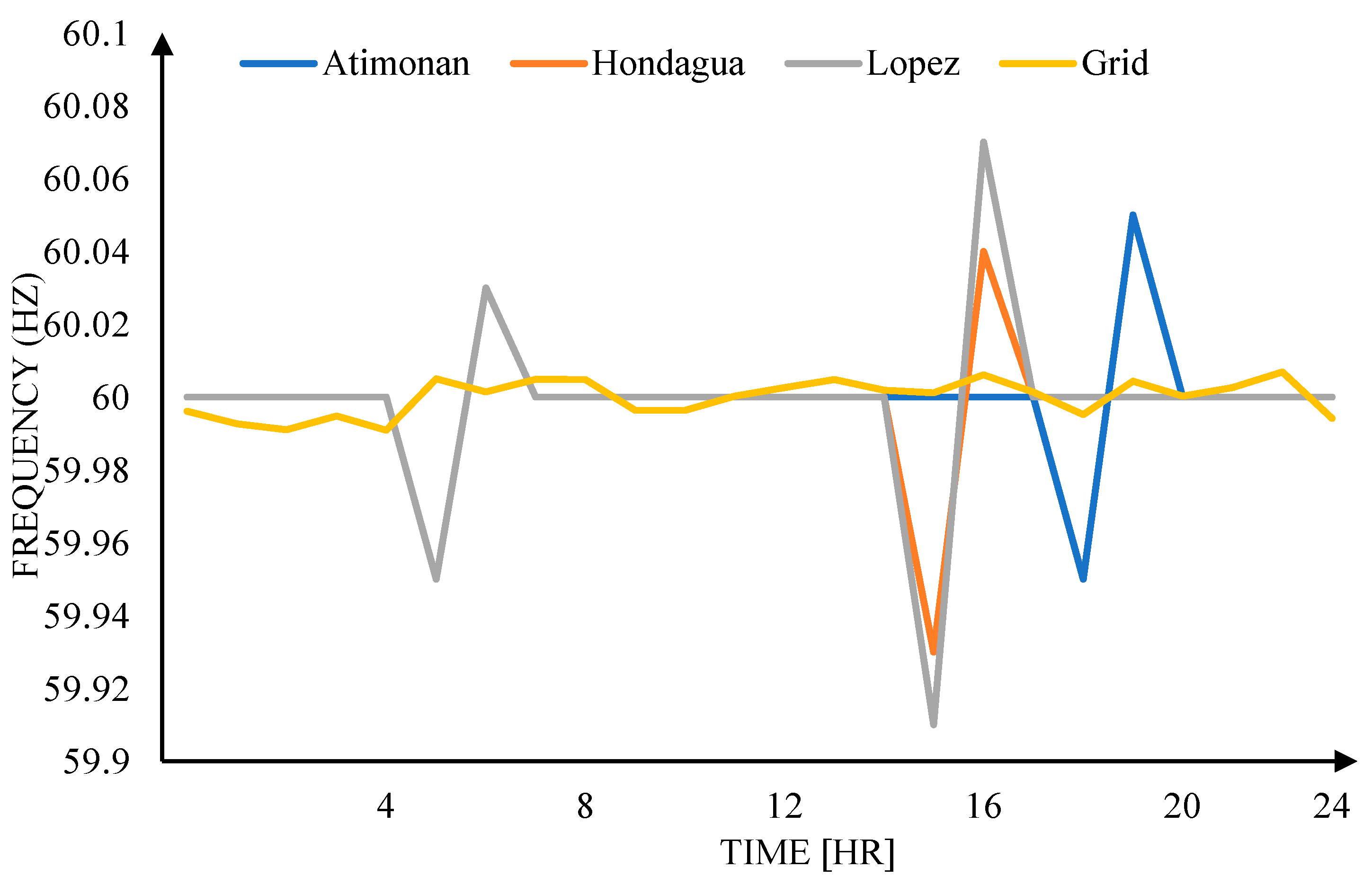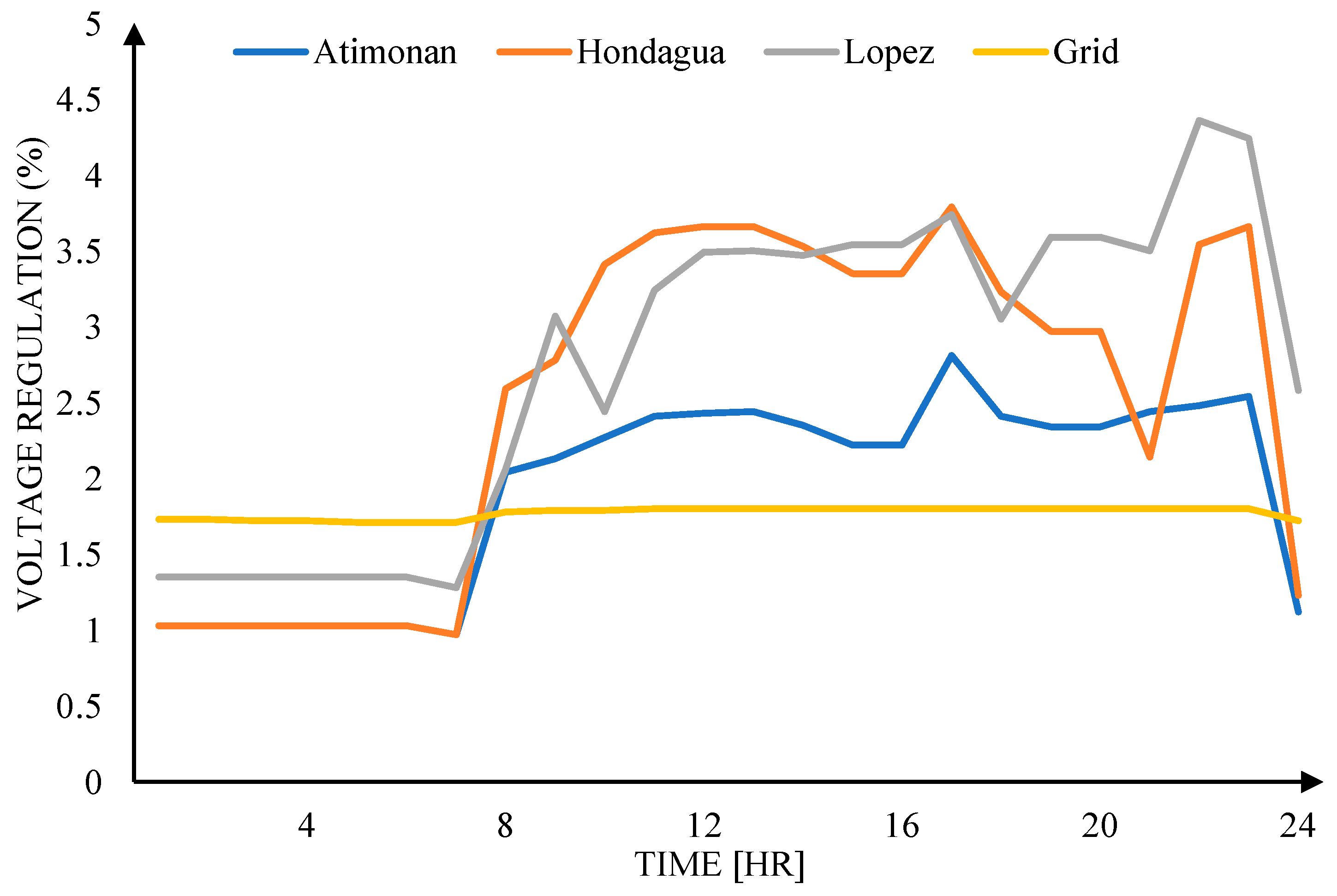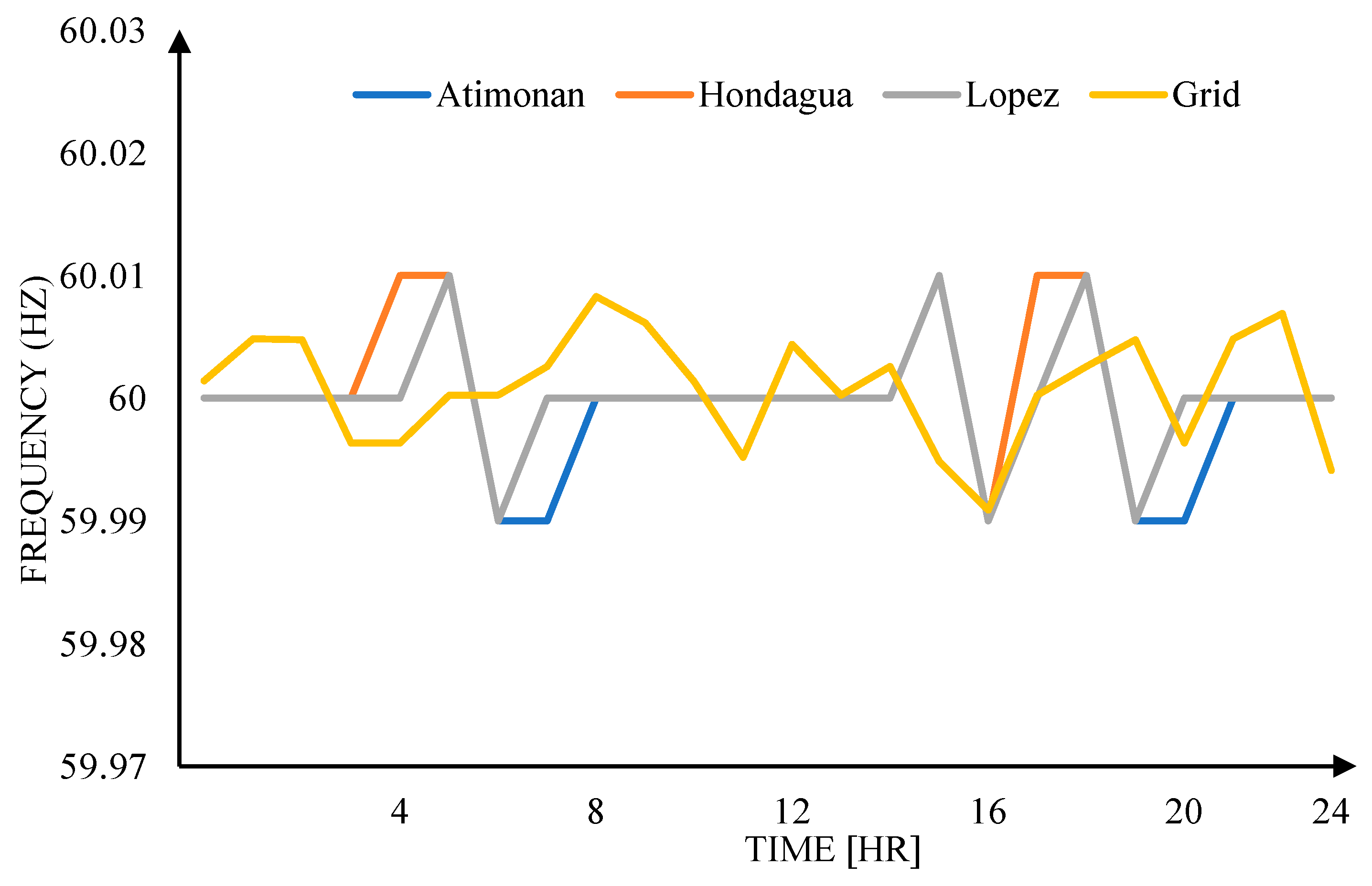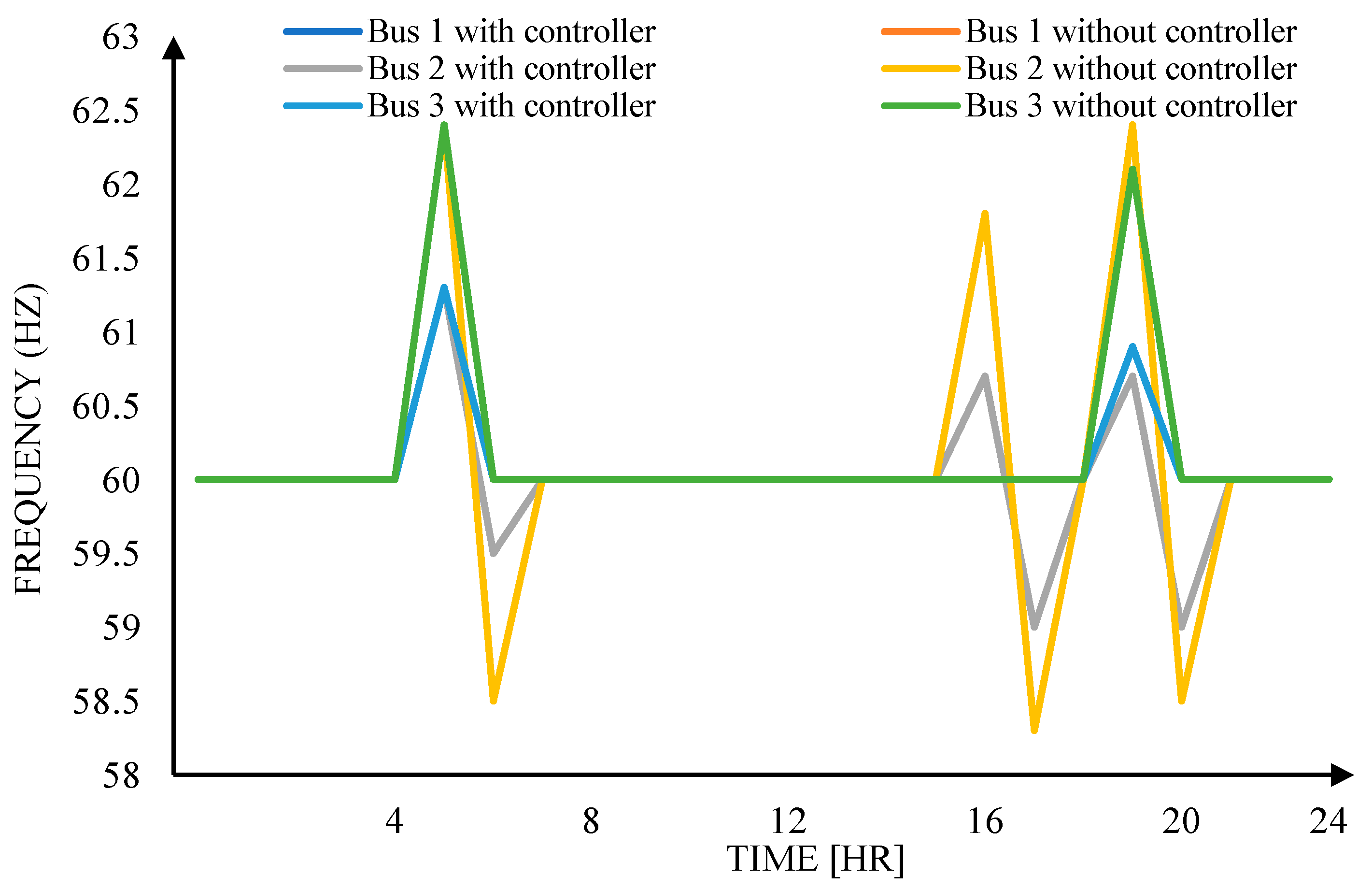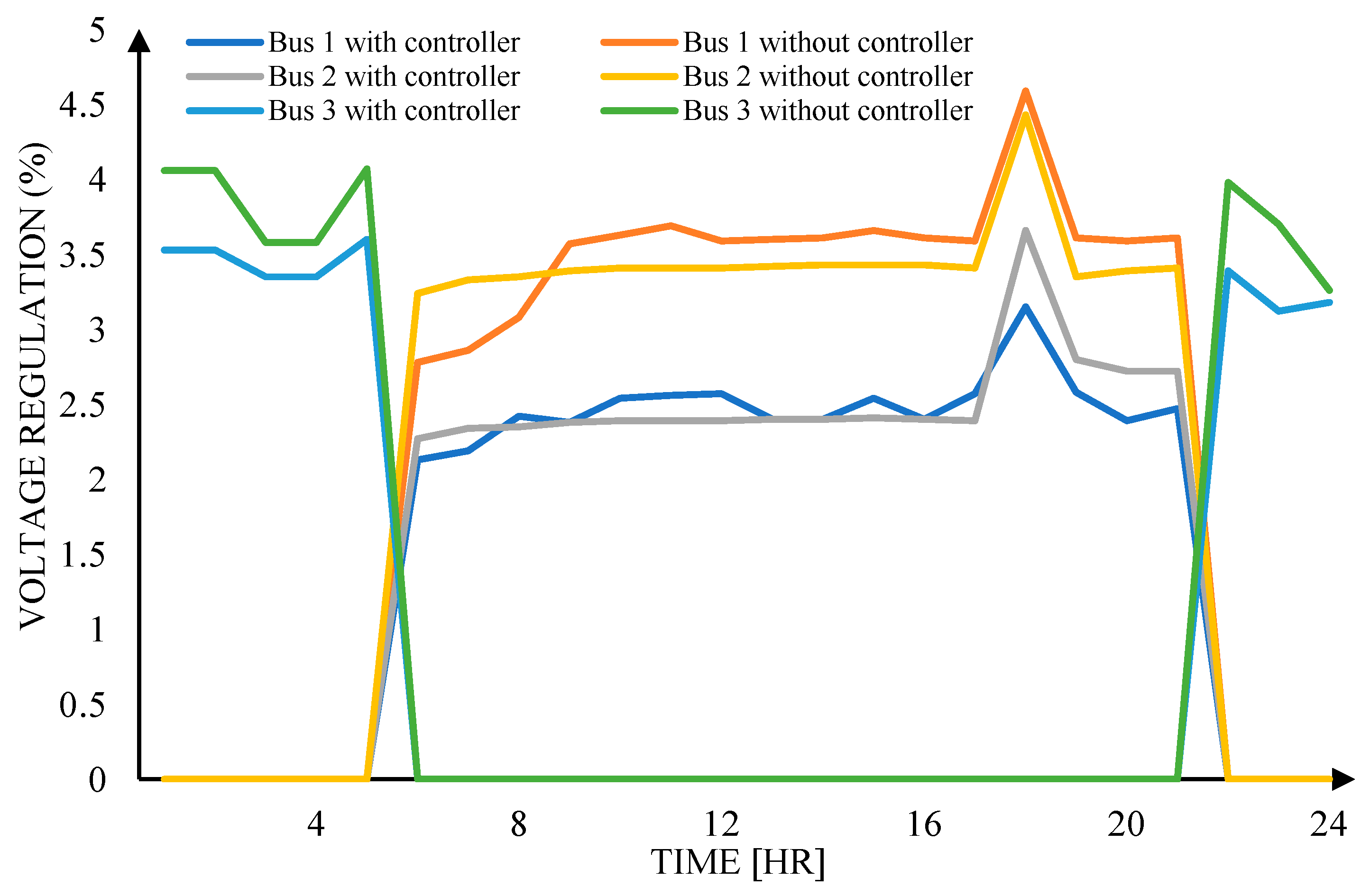1. Introduction
Renewable energy (RE) is widely considered to reduce total energy consumption through clean energy generation. Renewable energy sources (RESs) play a crucial role in the transition to sustainable development due to their superiorities over conventional energy sources (CESs). Being inexhaustible, environmentally friendly and usable in district areas are some of the advantages of RESs over CESs [
1]. RESs have been steadily growing and supported due to the increased demand for electric energy throughout the world for the past years. In the Philippines, a total of 20.4 percent of total power energy demand is projected to be supplied from renewable energy, with an average annual growth of 2.0 percent in the year 2040 [
2].
This development in modern power systems put the microgrid (MG) at the center of attention in the power industry. An MG is defined as a group of interconnected loads and distributed energy resources within clearly defined electrical boundaries that acts as a single controllable entity with respect to the grid [
3] forming a self-sufficient energy system.
Figure 1 shows an example of an integrated microgrid structure from IEEE Std 2030.9 [
4]. It can be operated in three possible modes: grid-connected, islanded, or isolated. During grid-connected operation, the MG is connected to the public grid through a common point with active interaction in the distribution system, and when the MG disconnects from the grid, whether due to a planned action or a fault/disturbance in the main grid, it changes into an islanded operation, while the isolated operation is when the MG is designed such that it is never connected to the grid.
MGs offer a viable solution in the integration of RESs in the power system. However, various considerations such as electrical load variation and the unpredictable nature of renewable energy resources impose challenges in achieving stability, effectiveness, security, and optimal operation in the power system. In references [
5,
6,
7], maintaining the balance between supplied power and power demand have been a challenge by imposing few adverse effects on the traditional main power grid due to effects of variation in the wind speed. For solar-based generation systems, solar irradiance and temperature are very important variables that directly impact the output. Due to its nature, solar power changes significantly with the time of day, time of year, and geographic location. In references [
8,
9,
10], a cloud enhancement effect influenced the PV system when it generated over-irradiance during the event. Similar to solar and wind, other RESs deal with other issues as well; for geothermal and biomass energy sources, the main concern lies in environmental issues [
11,
12], sizing of energy storage issue for tidal energy [
13], and regulation issues with other RES concerns in hydro energy [
14]. Generally, solar and wind energy systems are thought to be the most promising of all RESs because of being environmental friendly, simple in nature, and readily available.
As mentioned, reliance on weather, climatic change, and their unpredictable nature are typical issues for RES-based energy systems. This problem is said to be reduced by combining more than one source as a hybrid energy system to improve reliability and performance [
15]. In a successful hybrid, energy sources complement each other [
16], which means that the strength of one source can help in reducing the other’s weakness, which improves the system efficiency and reliability. In reference [
17], combined heat and power (CHP), wind power, ESS, and local distributed power generation are combined for improved power supply reliability and response during emergencies. A proposed hybrid energy system in [
18] which combined PV array, wind power, ESS, fuel cell (FC), and a diesel generator was developed for standalone MG in Batanes, Philippines to satisfy the load demand in the area. An integration in the main grid of a wind, solar, and hydro energy system in [
19] provided a reliable power system in Ethiopia which reduces power interruption. Lastly, Ref. [
20] models a hybrid renewable power system for Calayan Island, Cagayan, considering PV, wind turbines, diesel generators, a micro-hydro plant, and batteries.
In the above-mentioned studies where combined energy systems were maximized for power reliability, Refs. [
17,
19] failed to consider load demand forecasting for predicting future consumption for operation in a certain area; also, Ref. [
17] failed to consider available meteorological forecasted data factors in power production such as wind speed, irradiance, and temperature. In addition, Refs. [
17,
18,
19] failed to evaluate grid frequency performance as the penetration of a RES in a grid will create negative impact which affects the safeness, stability, and reliability of the operation; they also failed to operate the system in either grid-connected, islanded, or isolated operations.
This study focuses on studying the local power distribution in the Philippines, where the existing limitations have been surpassed. A proposed hybrid microgrid system, combining photovoltaic (PV) and fuel cell (FC) technologies without a storage facility, is designed. The objective is to optimize load forecasting and upgrade the distribution system by 2030. This is achieved by utilizing previous historical load demand data through an interpolation method to predict future load demand values.
In order to determine the feasibility of producing sufficient energy to support the local power distribution system, careful consideration is given to available meteorological data. Additionally, an embedded algorithm for maximum power point tracking (MPPT) control is implemented to address uncertainties associated with energy harnessing.
The hybrid microgrid system operates in two modes: on-grid mode, where both PV-FC and the local grid alternately supply the system, and islanded mode, where the system is solely supplied by PV-FC using a modified voltage source converter (VSC).
To enhance the design process, a robust design approach incorporating various factors is developed. Furthermore, the effectiveness of the proposed modified VSC is evaluated using the IEEE-14 Bus Test System configuration.
The major contributions of this paper can be summarized as follows.
A proposed hybrid microgrid in a local power distribution system that can operate in grid-connected, islanded, or isolated mode.
A proposed system algorithm for local power distribution system load forecasting and RES generation sizing based on available meteorological data.
Performance evaluation and analysis of the proposed system using Matlab/Simulink.
Generation of a test case system with application of the Taguchi design method for optimizing the design parameters of the proposed distribution system.
Evaluation of the effectiveness of a modified voltage frequency control strategy to operate in on-grid and off-grid modes based on the IEEE 14 Bus Test System.
Successful results and implementation of the system innovate the deployment of a hybrid microgrid system in a local power distribution system.
The remainder of this work is organized as follows:
Section 2 provides an overview of the QUEZELCO 1 Distribution System. The design systems for PV, FC, and modified VSC are explained and defined in
Section 3.
Section 4 presents different case studies, evaluation processes, simulations, results, and discussions. Lastly,
Section 5 discusses the conclusion of the study and its implications.
4. Discussion
In this paper, the effectiveness of an MG system is observed by implementing the PV-FC microgrid in three out of the eight available subsystems, namely Atimonan, Hondagua, and Lopez. The PV–FC MG system, along with the proposed modified VSC controller, was applied in three different cases to determine its effects on the local power distribution system.
4.1. Case 1, 2 and 3 Simulation Results
The voltage regulation for Case 1 ranges from 0.1% to 1.0%, for Case 2 it ranges from 1.2% to 2.7%, and for Case 3 it ranges from 0.9% to 4.5%. Ideally, Case 1 exhibits the best voltage regulation due to the ideal conditions of the power utility [
35] in the simulation, where no disturbances are considered. In contrast, Case 2 and Case 3 have higher voltage regulation compared to Case 1 due to the variance in the load-supply relation. However, the voltage regulation for all three cases falls within the standard range.
The distribution power losses for Case 1 range from 1.25 MVA to 2.5 MVA, for Case 2 it ranges from 0.8 MVA to 2.1 MVA, and for Case 3 it ranges from 0.9 MVA to 2.5 MVA. Distribution power losses are primarily accumulated in power transmission lines [
36], which is one of the reasons why Case 1 and Case 3 accumulate more losses due to power transmission from the substation to end-users, compared to Case 2. Nonetheless, the distribution power losses for all three cases are within the standard range.
In the system, two frequencies are measured for all cases: the main distribution frequency and the MG frequency. The main distribution frequency represents the frequency of the main distribution system and, similar to voltage regulation, it is measured at the nominal value of 60 Hz under ideal conditions. On the other hand, the MG frequency is the measured power frequency at the microgrid level. In Case 1, the frequency is maintained at the nominal value of 60 Hz as the power supply is directly connected to the main distribution. In Case 2, the frequency fluctuates by ±0.5 Hz due to switching between PV and FC supply. In Case 3, the frequency fluctuates by ±0.1 Hz due to switching between PV, FC, and power utility supply. The distribution and MG frequencies for all three cases fall within the standard range.
4.2. Evaluation and Verification Results
Having only one scenario can result in shortcomings in the study. Therefore, the Taguchi method is adopted to consider different scenarios and explore the overall effect on the distribution system when multiple factors such as grid setup, the application of capacitors, or additional feeders are involved. The evaluation runs 9 experiments with different scenarios, as shown in
Table 6.
Table 11 displays the optimal levels for each factor: (A) conventional for grid setup, (B) with application of shunt capacitor, and (C) with application of series feeder.
In power systems with RES and load disturbances, the conventional power system setup performs better in terms of frequency response and voltage regulation compared to the DGs (distributed generations). However, the conventional power system accumulates power losses that are twice as much as the losses in the DGs due to the complex and long-distance transmission lines in the conventional setup. The application of capacitors and parallel feeders enhances the performance of both conventional and DGs power systems. With the application of capacitors and parallel feeders, power losses decrease, and both frequency and voltage are regulated to the standard level. On the other hand, the series feeder does not provide better response in any aspect and generates more power losses due to additional resistance in conductors, which may eventually lead to power disturbances.
The proposed modified VSC controller is applied and simulated on the IEEE 14-Bus Test System [
25] for comparison purposes. The simulation results are presented and discussed.
Figure 8 shows the test system, which consists of 14 buses, with 3 buses allocated for power sources and 11 buses for loads. Unlike the conventional IEEE-14 Bus System, the system in this study utilizes 2 buses for hybrid RES such as PV and FC, where the proposed modified VSC controller is applied, and 1 bus for the grid source instead of having 3 buses of power sources coming from the utility.
As observed, there are spikes in
Figure 19 and
Figure 20, representing frequency and voltage regulation, respectively. These spikes signify the switching of power sources from one bus to another.
Figure 19 and
Figure 20 record 3 spikes during the simulation: the first spike signifies the switching of power source from the utility to the PV source, the second spike represents the switching from the PV source to the FC source, and the last spike denotes the switching from the FC source back to the utility source.
It is evident from the simulation results that the IEEE-14 Bus System with the proposed modified VSC controller exhibits better frequency and voltage regulation compared to the IEEE-14 Bus System without the proposed controller. The spikes in both frequency and voltage regulation are reduced with the modified VSC controller, highlighting its advantage.
5. Conclusions
In conclusion, this study presents a comprehensive study on the implementation of a combined PV system and FC system as a hybrid power source for local power distribution in the Philippines. The analysis considers the forecasted load and meteorological limitations of the location to optimize the system’s performance. By applying the historical load demand and considering the meteorological constraints, the uncertainties in the power system are minimized.
The use of the Taguchi method and the application of the proposed system to the IEEE-14 Bus Test System provide valuable insights into designing the hybrid MG. These approaches allow for the evaluation of key areas and parameters to achieve optimal performance. The successful validation of the proposed system on a larger scale using the IEEE-14 Bus Test System adds credibility to the study.
The results demonstrate that both on-grid and islanded operations respond effectively to the modified VSC controller, ensuring compliance with international standards. The application of the hybrid MG significantly reduces power losses within the system. The selection of an appropriate control design enables the successful implementation of an MG system.
Overall, the performance of the proposed modified VSC controller is found to be satisfactory, showcasing the potential of the hybrid MG power system for local power distribution. This research contributes to advancing the field of renewable energy integration and lays the foundation for future studies in optimizing MG systems.
For future study, identification of supply sources of materials for the system, type of material, and cost shall be declared for the feasibility of the proposed system.

